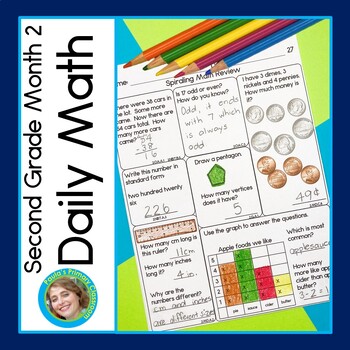2nd Grade Math Spiral Review Worksheet Warm Ups Morning Work Packets October
Paula's Primary Classroom
5k Followers
Grade Levels
2nd, Homeschool
Subjects
Resource Type
Standards
CCSS2.MD.A.1
CCSS2.MD.A.2
CCSS2.MD.B.5
CCSS2.MD.B.6
CCSS2.MD.C.7
Formats Included
- PDF
Pages
28 pages
Paula's Primary Classroom
5k Followers
What educators are saying
This is great to see what my students know and don't know. Also is great for data collection towards IEP goals
Also included in
- These 2nd grade math review packets are perfect 2nd grade spiral morning work, daily math warm ups or bell ringers & will engage your students in learning & reviewing all CCSS math skills this spring & all year long! It's 180 NO PREP spiraling worksheets with all instructions & answePrice $21.95Original Price $36.00Save $14.05
- This math spiral review is perfect for morning work or daily math warm up and will have your second graders engaged in learning and reviewing all second grade CCSS for math! It includes 180 printable pages and answer keys, and 180 digital assignments and answer keys, all instructions, and links to 3Price $47.00Original Price $72.00Save $25.00
Description
These math spiral review worksheets are perfect for morning work, daily math warm up or homework and will have your 2nd graders engaged in learning and reviewing many math skills! It includes 20 pages, designed for October / the 2nd month of second grade, with all instructions and answer keys included, and each problem is labeled with CCSS for math! There's even links to 20 video mini lessons your students can watch to check their work - you'll love how easy it is to cover the CCSS for Math with this NO PREP resource!
With this resource your students will:
- Solve one step word problems with answers to 100 with regrouping
- Practice addition and subtraction within 20
- Count by 2's, 5's and 10's to find missing numbers
- Identify numbers as odd or even, circle pairs of objects to determine odd / even
- Identify numbers represented as groups of 100s, 10s and 1's, including sets of 100s
- Work with standard and expanded form of 3 digit numbers
- Add and subtract within 100 with regrouping
- Mentally +10 and -10 within 300
- Measure inches and centimeters, choose appropriate tools to measure
- Measure the same object in inches and centimeters, describe how the answers relate to the size of the unit of measure
- Find whole numbers up to 100 on a number line, find sums and differences within 100 on a number line
- Tell time to the quarter hour
- Count mixed coins with pennies, nickels and dimes
- Use repeated measurement to create and read line plots
- Answer questions about bar graphs (up to 4 categories)
- Identify and draw shapes
- Divide rectangles and circles into halves, thirds and quarters.
Click here to be notified when new resources are released at 50% off!
You may also like:
Thank you for visiting Paula's Primary Classroom!
- Join my email list & get freebies!
- Follow me on FaceBook.
- Follow me on Instagram.
- Follow me on Pinterest.
Have a great day!
♥ Paula
Total Pages
28 pages
Answer Key
Included
Teaching Duration
1 month
Report this resource to TPT
Reported resources will be reviewed by our team. Report this resource to let us know if this resource violates TPT’s content guidelines.
Standards
to see state-specific standards (only available in the US).
CCSS2.MD.A.1
Measure the length of an object by selecting and using appropriate tools such as rulers, yardsticks, meter sticks, and measuring tapes.
CCSS2.MD.A.2
Measure the length of an object twice, using length units of different lengths for the two measurements; describe how the two measurements relate to the size of the unit chosen.
CCSS2.MD.B.5
Use addition and subtraction within 100 to solve word problems involving lengths that are given in the same units, e.g., by using drawings (such as drawings of rulers) and equations with a symbol for the unknown number to represent the problem.
CCSS2.MD.B.6
Represent whole numbers as lengths from 0 on a number line diagram with equally spaced points corresponding to the numbers 0, 1, 2,..., and represent whole-number sums and differences within 100 on a number line diagram.
CCSS2.MD.C.7
Tell and write time from analog and digital clocks to the nearest five minutes, using a.m. and p.m.







